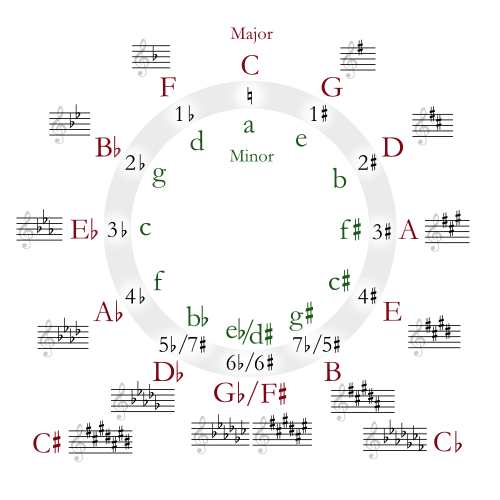Minor scale
A minor scale in music theory is any scale that has at least three scale degrees: the tonic, the minor third above the tonic, and the perfect fifth above the tonic. Together they make the minor triad. This includes many scales and modes such as Dorian mode and the Phrygian mode.
In simple terms, a minor scale is a series of notes with a sad, somber character (exaggerated when heard back-to-back with a major scale). A minor scale begins on the sixth note of its relative major scale, and is built with the following pattern of half steps and whole steps:
i_whole_ii°_half_III_whole_iv_whole_v_half_VI_whole_VII_whole _i (next octave)
(e -------- f#° ------ G ---------- a --------- b ------- C ---------- D ---------- e)
Usually, when people talk about minor scales, they mean natural minor, harmonic minor, or melodic minor scales, which are the most common in Western music.
Natural Minor
The natural minor scale is the same as the 6th mode (or Aeolian mode) of the major scale. For example, the white notes of a keyboard from one C to the next C up makes a C major scale. If the white notes are played starting from the sixth step of that C scale, (from any A to the next A), then an A natural minor scale (the "relative minor" of C) is produced.
Harmonic and melodic minor
The harmonic minor scale is the same as the natural minor but with the seventh note raised by a semitone.
Harmonic Minor Scale: 1 2 3♭ 4 5 6♭ 7 8
For example, in the key of A minor, the harmonic minor scale is:
A B C D E F G♯ A
One way the harmonic minor is different to the natural minor is that it has two chords which have the same structure when inverted, so they do not belong to any key. These are the diminished seventh chord (2nd, 4th, 6th and 7th degrees) and the augmented chord (the 3rd, 5th and 7th degrees).
The harmonic minor is also sometimes called the Mohammedan scale[1] because its upper tetrachord is the same as the Hijaz jins, often found in Middle Eastern music. The harmonic minor scale as a whole is sometimes called Nahawand-Hijaz[2] in Arabic, or as Bûselik Hicaz [3] in Turkish.
The interval between the sixth and seventh degrees of this scale (in this case F and G♯) is an augmented second. While some composers, like Mozart, have used this interval in melodic composition, other composers found it awkward. They thought that a whole step between these two scale degrees was better for smooth melody writing, so they used the subtonic seventh, or raised the sixth scale degree. These two options are called the ascending melodic minor scale and descending melodic minor scale. The ascending has the same upper tetrachord to the major scale, and the descending is the same as the natural minor:
A B C D E F♯ G♯ A' and then
A' G F E D C B A respectively.
Many composers do not stick to the notes of only one of these scales when writing music. Using the triad of the relative major is very common, but because this is based on the third degree of the minor scale, the raised seventh degree of the harmonic scale would cause an augmented triad. In this case, composers usually use the natural minor. In jazz, usually only the ascending minor is used.
Finding key signatures
Major and minor keys that share the same key signature are called relative; so C major is the relative major of A minor, and C minor is the relative minor of E♭ major. The relative major is a minor third above the tonic of the minor. For example, since the key signature of G major has one sharp (see major scales for how to find this), its relative minor, E minor, also has one sharp in its key signature.
Music may be written in an enharmonic scale (e.g. A♭ major, which only has four flats in its key signature, compared to the eight sharps required for G♯ major). The following are enharmonic equivalents:
| Key Sig. | Major Scale | Minor Scale | ||
|---|---|---|---|---|
| 5♯/7♭ | B/C♭ major | g♯/a♭ minor | ||
| 6♯/6♭ | F♯/G♭ major | d♯/e♭ minor | ||
| 7♯/5♭ | C♯/D♭ major | a♯/b♭ minor |
Minor Scale Media
Related pages
Notes
- ↑ "United States Patent: 5386757". Archived from the original on 2015-12-17. Retrieved 2010-03-16.
- ↑ "The Oud". Archived from the original on 2011-07-20. Retrieved 2010-03-16.
- ↑ "The Oud". Archived from the original on 2010-01-18. Retrieved 2010-03-16.
References
- Gjerdingen, Robert O. (1990). "A Guide to the Terminology of German Harmony", Studies in the Origin of Harmonic Tonality by Dahlhaus, Carl, trans. Gjerdingen (1990).
Other websites
- 3 note per string Harmonic Minor scale shapes for guitar in PDF format for easy printing
- Proper fingering of the major and minor scales on the piano
- Listen to and download harmonised minor scale piano MP3s
- Guitar: Harmonic minor scale explored Archived 2008-04-28 at the Wayback Machine
- The harmonic minor scale on the guitar





